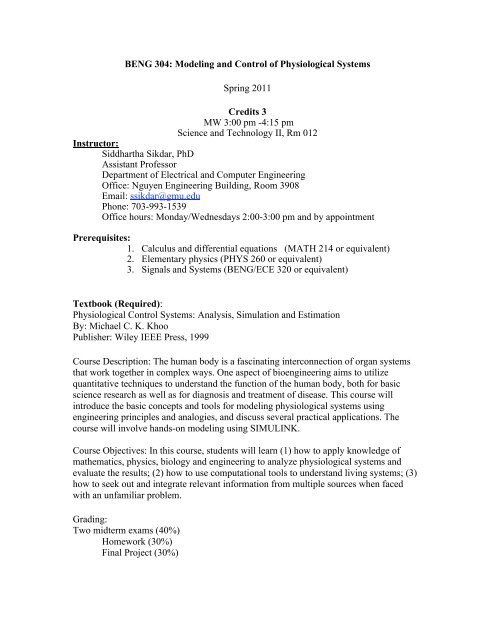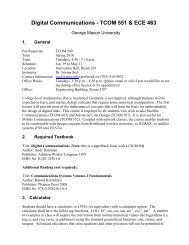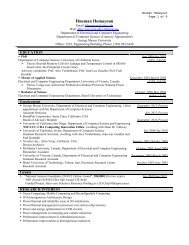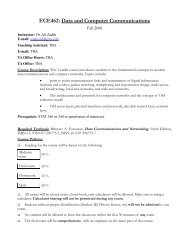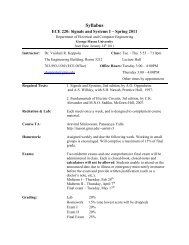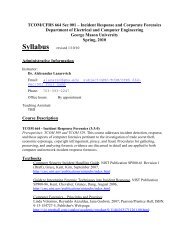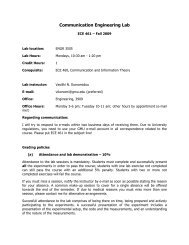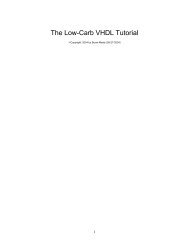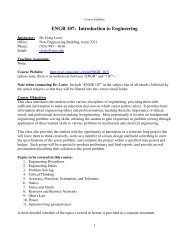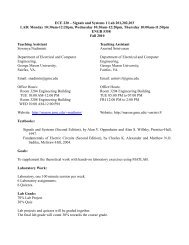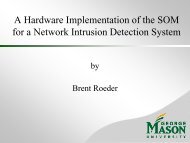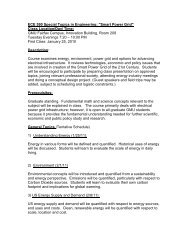BENG 304 Modeling and Control of Physiological Systems
BENG 304 Modeling and Control of Physiological Systems
BENG 304 Modeling and Control of Physiological Systems
You also want an ePaper? Increase the reach of your titles
YUMPU automatically turns print PDFs into web optimized ePapers that Google loves.
<strong>BENG</strong> <strong>304</strong>: <strong>Modeling</strong> <strong>and</strong> <strong>Control</strong> <strong>of</strong> <strong>Physiological</strong> <strong>Systems</strong><br />
Spring 2011<br />
Credits 3<br />
MW 3:00 pm -4:15 pm<br />
Science <strong>and</strong> Technology II, Rm 012<br />
Instructor:<br />
Siddhartha Sikdar, PhD<br />
Assistant Pr<strong>of</strong>essor<br />
Department <strong>of</strong> Electrical <strong>and</strong> Computer Engineering<br />
Office: Nguyen Engineering Building, Room 3908<br />
Email: ssikdar@gmu.edu<br />
Phone: 703-993-1539<br />
Office hours: Monday/Wednesdays 2:00-3:00 pm <strong>and</strong> by appointment<br />
Prerequisites:<br />
1. Calculus <strong>and</strong> differential equations (MATH 214 or equivalent)<br />
2. Elementary physics (PHYS 260 or equivalent)<br />
3. Signals <strong>and</strong> <strong>Systems</strong> (<strong>BENG</strong>/ECE 320 or equivalent)<br />
Textbook (Required):<br />
<strong>Physiological</strong> <strong>Control</strong> <strong>Systems</strong>: Analysis, Simulation <strong>and</strong> Estimation<br />
By: Michael C. K. Khoo<br />
Publisher: Wiley IEEE Press, 1999<br />
Course Description: The human body is a fascinating interconnection <strong>of</strong> organ systems<br />
that work together in complex ways. One aspect <strong>of</strong> bioengineering aims to utilize<br />
quantitative techniques to underst<strong>and</strong> the function <strong>of</strong> the human body, both for basic<br />
science research as well as for diagnosis <strong>and</strong> treatment <strong>of</strong> disease. This course will<br />
introduce the basic concepts <strong>and</strong> tools for modeling physiological systems using<br />
engineering principles <strong>and</strong> analogies, <strong>and</strong> discuss several practical applications. The<br />
course will involve h<strong>and</strong>s-on modeling using SIMULINK.<br />
Course Objectives: In this course, students will learn (1) how to apply knowledge <strong>of</strong><br />
mathematics, physics, biology <strong>and</strong> engineering to analyze physiological systems <strong>and</strong><br />
evaluate the results; (2) how to use computational tools to underst<strong>and</strong> living systems; (3)<br />
how to seek out <strong>and</strong> integrate relevant information from multiple sources when faced<br />
with an unfamiliar problem.<br />
Grading:<br />
Two midterm exams (40%)<br />
Homework (30%)<br />
Final Project (30%)
Module Week Topics<br />
Module 1.<br />
Introduction to<br />
physiological<br />
1<br />
(1/24,<br />
1/26)<br />
modeling 2<br />
(1/31,<br />
Module 2.<br />
The mathematical<br />
tools<br />
Module 3 A.<br />
Building blocks:<br />
Cardiovascular <strong>and</strong><br />
Respiratory system<br />
Module 3 B.<br />
Building blocks:<br />
Nervous system.<br />
Module 3 C.<br />
Building blocks:<br />
Musculoskeletal<br />
system.<br />
Module 3 D.<br />
Building blocks:<br />
Endocrine system<br />
Module 4.<br />
Putting it all<br />
together: <strong>Modeling</strong><br />
complex<br />
physiological<br />
control systems<br />
2/2)<br />
3<br />
(2/7,<br />
2/9)<br />
4<br />
(2/14,<br />
2/16)<br />
5<br />
(2/21,<br />
2/23)<br />
6<br />
(2/28,<br />
3/2)<br />
7<br />
(3/7,<br />
3/9)<br />
3/14-<br />
3/20<br />
9<br />
(3/21,<br />
3/23)<br />
10<br />
(3/28,<br />
3/30)<br />
11<br />
(4/4,<br />
4/6)<br />
12<br />
(4/11,<br />
4/13)<br />
13<br />
(4/18,<br />
4/20)<br />
14<br />
(4/25,<br />
• What is a model? Why model?<br />
• Multiscale organization <strong>of</strong> living organisms: cell to organ<br />
• Homeostasis. Examples <strong>of</strong> physiological control systems.<br />
• Review <strong>of</strong> linear systems concepts<br />
• Fourier series: <strong>Modeling</strong> signals using Fourier series<br />
• Deterministic <strong>and</strong> stochastic signals <strong>and</strong> systems<br />
• Basic concepts <strong>of</strong> control systems; Open vs. closed loop<br />
• Steady state <strong>and</strong> transient analysis <strong>of</strong> control systems<br />
• Linear models vs nonlinear models<br />
• Distributed vs. lumped parameter models<br />
• Compartment models<br />
• Circulatory system. Key events in the cardiac cycle.<br />
• Blood pressure <strong>and</strong> flow, vascular impedance<br />
• Lumped parameter models, windkessel model <strong>of</strong><br />
circulation<br />
• Cardiac mechanics.<br />
• Respiratory mechanics, lung models<br />
• Mid term Exam 1<br />
Spring Break<br />
• Review anatomy <strong>and</strong> physiology <strong>of</strong> nerves. Review basics<br />
<strong>of</strong> bioelectricity.<br />
• Action potentials<br />
• Hodgkin-Huxley model<br />
• Review anatomy <strong>and</strong> physiology <strong>of</strong> muscle. How muscles<br />
contract<br />
• Hill model <strong>of</strong> muscle contraction<br />
• Muscle stretch reflex<br />
• Enzymes <strong>and</strong> hormones<br />
• Michaelis-Menten enzyme kinetics<br />
• Examples <strong>of</strong> endocrine control: glucose-insulin system,<br />
thyroid hormone system.<br />
• Mid term Exam 2<br />
<strong>Modeling</strong> regulation <strong>of</strong> cardiac output<br />
• Starling’s law, pressure-volume curves<br />
• Coupled model <strong>of</strong> cardiopulmonary system<br />
<strong>Modeling</strong> blood pressure regulation<br />
• Baroreceptor reflex.<br />
• The role <strong>of</strong> the kidney in blood pressure regulation<br />
<strong>Modeling</strong> blood glucose regulation<br />
• Insulin control <strong>of</strong> glucose
Module 5.<br />
Wrap up<br />
4/27) • Glucose utilization in muscle<br />
15<br />
(5/2,<br />
5/4)<br />
16<br />
(5/16)<br />
• Model parameter estimation, sensitivity analysis.<br />
• Course review.<br />
• Final Project Presentations<br />
• Project report due<br />
Course structure:<br />
The course will consist <strong>of</strong> two weekly lectures, homework assignments, two<br />
midterm exams <strong>and</strong> a final project. The homework assignments will involve some<br />
programming in SIMULINK <strong>and</strong> analysis <strong>of</strong> SIMULINK models. The exams will be<br />
closed book <strong>and</strong> closed notes. The project will involve h<strong>and</strong>s-on implementation <strong>of</strong> a<br />
model <strong>of</strong> a physiological sub-system.<br />
Homework:<br />
There will be assigned homework throughout the semester. The homework will<br />
involve processing <strong>and</strong> analysis <strong>of</strong> real signals, <strong>and</strong> will involve programming <strong>and</strong><br />
analysis <strong>of</strong> models. Homework submitted after the due date will be penalized (15%<br />
penalty for each day late). No homework will be accepted after one week from the due<br />
date.<br />
5 points <strong>of</strong> the homework grade is reserved for class participation. One student<br />
will be assigned each week on a rotating basis to take the lead on compiling a summary<br />
<strong>of</strong> the discussions in class. The student should compare notes with other students <strong>and</strong> post<br />
their summary on the discussion board on the class home page. These summaries should<br />
be used as a supplement to the lecture slides in preparing for examinations. The class<br />
participation grade will be based on the quality <strong>of</strong> these discussion summaries.<br />
Midterm Exams:<br />
The midterm exams will be closed book <strong>and</strong> notes. They will consist <strong>of</strong> a mixture<br />
<strong>of</strong> essay-type, multiple-choice type questions <strong>and</strong> numerical problems. Absence from<br />
exams must be notified ahead <strong>of</strong> time <strong>and</strong> alternative arrangements made with the<br />
instructor.<br />
Project:<br />
The students will be required to do an individual course project that will integrate<br />
the material learnt in the course. The project presentations <strong>and</strong> final project report will<br />
substitute for a traditional final exam. The project topic can be chosen from a list <strong>of</strong><br />
suggested topics. Typically the project will involve development <strong>and</strong> analysis <strong>of</strong> a model<br />
<strong>of</strong> a physiological sub-system. The student will be expected to seek out <strong>and</strong> integrate<br />
relevant information <strong>and</strong> demonstrate an ability to apply knowledge <strong>of</strong> mathematics,<br />
physics, biology <strong>and</strong> engineering to analyze physiological systems <strong>and</strong> evaluate the<br />
results. Students will develop sections <strong>of</strong> the project report throughout the semester <strong>and</strong><br />
receive feedback.<br />
Academic Honesty <strong>and</strong> Collaboration:
The integrity <strong>of</strong> the University community is affected by the individual choices<br />
made by each <strong>of</strong> us. GMU has an Honor Code with clear guidelines regarding academic<br />
integrity. Three fundamental <strong>and</strong> rather simple principles to follow at all times are that:<br />
(1) all work submitted be your own; (2) when using the work or ideas <strong>of</strong> others, including<br />
fellow students, give full credit through accurate citations; <strong>and</strong> (3) if you are uncertain<br />
about the ground rules on a particular assignment, ask for clarification. No grade is<br />
important enough to justify academic misconduct.<br />
With collaborative work, names <strong>of</strong> all the participants should appear on the work.<br />
Homework problems are designed to be undertaken independently. You may discuss<br />
your ideas with others <strong>and</strong> conference with peers; however, it is not appropriate to give<br />
your work to someone else to review. You are responsible for making certain that there<br />
is no question that the work you h<strong>and</strong> in is your own. If only your name appears on an<br />
assignment, your pr<strong>of</strong>essor has the right to expect that you have done the work yourself,<br />
fully <strong>and</strong> independently.<br />
Plagiarism means using the exact words, opinions, or factual information from<br />
another person without giving the person credit. Writers give credit through accepted<br />
documentation styles, such as parenthetical citation, footnotes, or endnotes.<br />
Paraphrased material must also be properly cited. A simple listing <strong>of</strong> books or articles is<br />
not sufficient. Plagiarism is the equivalent <strong>of</strong> intellectual robbery <strong>and</strong> cannot be tolerated<br />
in the academic setting. If you have any doubts about what constitutes plagiarism, please<br />
see the instructor.<br />
Relevant Campus <strong>and</strong> Academic Resources<br />
Disability Services<br />
Any student with documented learning disabilities or other conditions that may<br />
affect academic performance should: 1) make sure this documentation is on file with the<br />
Office <strong>of</strong> Disability Services (SUB I, Rm. 222; 993-2474; www.gmu.edu/student/drc) to<br />
determine the accommodations you might need; <strong>and</strong> 2) talk with the instructor to discuss<br />
reasonable accommodations.<br />
Office <strong>of</strong> Diversity Programs <strong>and</strong> Services<br />
SUB 1, Rm. 345; 993-2700; www.gmu.edu/student/msaf/index.html<br />
Writing Center<br />
Robinson A116; 993-1200; writingcenter.gmu.edu.


